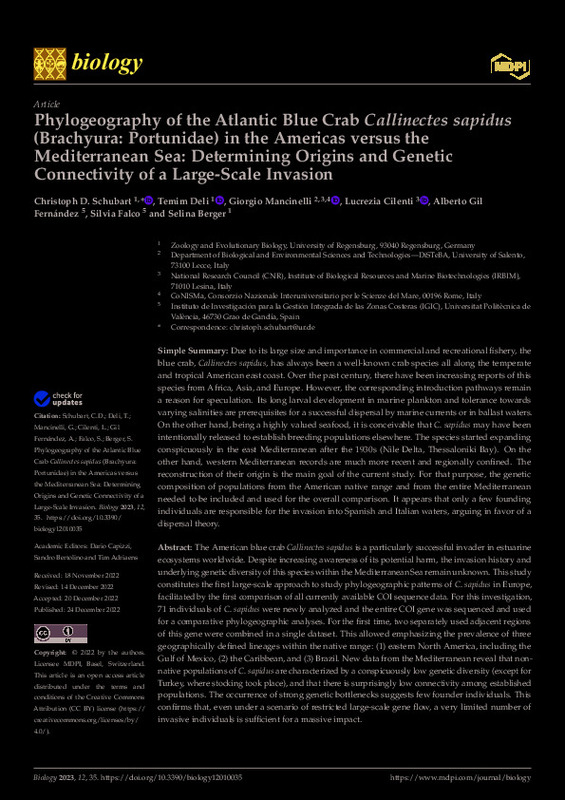JavaScript is disabled for your browser. Some features of this site may not work without it.
Buscar en RiuNet
Listar
Mi cuenta
Estadísticas
Ayuda RiuNet
Admin. UPV
Phylogeography of the Atlantic Blue Crab Callinectes sapidus (Brachyura: Portunidae) in the Americas versus the Mediterranean Sea: Determining Origins and Genetic Connectivity of a Large-Scale Invasion
Mostrar el registro sencillo del ítem
Ficheros en el ítem
| dc.contributor.author | Schubart, Christoph D.
|
es_ES |
| dc.contributor.author | Deli, Temim
|
es_ES |
| dc.contributor.author | Mancinelli, Giorgio
|
es_ES |
| dc.contributor.author | Cilenti, Lucrezia
|
es_ES |
| dc.contributor.author | Gil-Fernández, Alberto
|
es_ES |
| dc.contributor.author | Falco, S.
|
es_ES |
| dc.contributor.author | Berger, Selina
|
es_ES |
| dc.date.accessioned | 2023-03-06T19:00:50Z | |
| dc.date.available | 2023-03-06T19:00:50Z | |
| dc.date.issued | 2023-01 | es_ES |
| dc.identifier.uri | http://hdl.handle.net/10251/192358 | |
| dc.description.abstract | [EN] Due to its large size and importance in commercial and recreational fishery, the blue crab, Callinectes sapidus, has always been a well-known crab species all along the temperate and tropical American east coast. Over the past century, there have been increasing reports of this species from Africa, Asia, and Europe. However, the corresponding introduction pathways remain a reason for speculation. Its long larval development in marine plankton and tolerance towards varying salinities are prerequisites for a successful dispersal by marine currents or in ballast waters. On the other hand, being a highly valued seafood, it is conceivable that C. sapidus may have been intentionally released to establish breeding populations elsewhere. The species started expanding conspicuously in the east Mediterranean after the 1930s (Nile Delta, Thessaloniki Bay). On the other hand, western Mediterranean records are much more recent and regionally confined. The reconstruction of their origin is the main goal of the current study. For that purpose, the genetic composition of populations from the American native range and from the entire Mediterranean needed to be included and used for the overall comparison. It appears that only a few founding individuals are responsible for the invasion into Spanish and Italian waters, arguing in favor of a dispersal theory. The American blue crab Callinectes sapidus is a particularly successful invader in estuarine ecosystems worldwide. Despite increasing awareness of its potential harm, the invasion history and underlying genetic diversity of this species within the Mediterranean Sea remain unknown. This study constitutes the first large-scale approach to study phylogeographic patterns of C. sapidus in Europe, facilitated by the first comparison of all currently available COI sequence data. For this investigation, 71 individuals of C. sapidus were newly analyzed and the entire COI gene was sequenced and used for a comparative phylogeographic analyses. For the first time, two separately used adjacent regions of this gene were combined in a single dataset. This allowed emphasizing the prevalence of three geographically defined lineages within the native range: (1) eastern North America, including the Gulf of Mexico, (2) the Caribbean, and (3) Brazil. New data from the Mediterranean reveal that non-native populations of C. sapidus are characterized by a conspicuously low genetic diversity (except for Turkey, where stocking took place), and that there is surprisingly low connectivity among established populations. The occurrence of strong genetic bottlenecks suggests few founder individuals. This confirms that, even under a scenario of restricted large-scale gene flow, a very limited number of invasive individuals is sufficient for a massive impact. | es_ES |
| dc.language | Inglés | es_ES |
| dc.publisher | MDPI AG | es_ES |
| dc.relation.ispartof | Biology | es_ES |
| dc.rights | Reconocimiento (by) | es_ES |
| dc.subject | Atlantic Ocean | es_ES |
| dc.subject | Invasion biology | es_ES |
| dc.subject | Gene flow | es_ES |
| dc.subject | Genetic bottleneck | es_ES |
| dc.subject | Founder effect | es_ES |
| dc.subject | COI mitochondrial DNA | es_ES |
| dc.subject.classification | TECNOLOGIA DEL MEDIO AMBIENTE | es_ES |
| dc.title | Phylogeography of the Atlantic Blue Crab Callinectes sapidus (Brachyura: Portunidae) in the Americas versus the Mediterranean Sea: Determining Origins and Genetic Connectivity of a Large-Scale Invasion | es_ES |
| dc.type | Artículo | es_ES |
| dc.identifier.doi | 10.3390/biology12010035 | es_ES |
| dc.rights.accessRights | Abierto | es_ES |
| dc.contributor.affiliation | Universitat Politècnica de València. Escuela Politécnica Superior de Gandia - Escola Politècnica Superior de Gandia | es_ES |
| dc.description.bibliographicCitation | Schubart, CD.; Deli, T.; Mancinelli, G.; Cilenti, L.; Gil-Fernández, A.; Falco, S.; Berger, S. (2023). Phylogeography of the Atlantic Blue Crab Callinectes sapidus (Brachyura: Portunidae) in the Americas versus the Mediterranean Sea: Determining Origins and Genetic Connectivity of a Large-Scale Invasion. Biology. 12(1):1-18. https://doi.org/10.3390/biology12010035 | es_ES |
| dc.description.accrualMethod | S | es_ES |
| dc.relation.publisherversion | https://doi.org/10.3390/biology12010035 | es_ES |
| dc.description.upvformatpinicio | 1 | es_ES |
| dc.description.upvformatpfin | 18 | es_ES |
| dc.type.version | info:eu-repo/semantics/publishedVersion | es_ES |
| dc.description.volume | 12 | es_ES |
| dc.description.issue | 1 | es_ES |
| dc.identifier.eissn | 2079-7737 | es_ES |
| dc.identifier.pmid | 36671728 | es_ES |
| dc.identifier.pmcid | PMC9854962 | es_ES |
| dc.relation.pasarela | S\482148 | es_ES |








